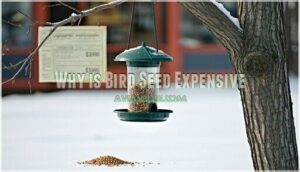This site is supported by our readers. We may earn a commission, at no cost to you, if you purchase through links.
 You’re facing sticker shock at the bird feeder aisle because multiple factors have created a perfect storm of rising costs.
You’re facing sticker shock at the bird feeder aisle because multiple factors have created a perfect storm of rising costs.
Global supply chain disruptions have made it harder to move seeds from farms to stores, while drought conditions have severely damaged crop yields, especially for popular sunflower seeds.
Many farmers have switched to more profitable crops, reducing the overall seed supply, and transportation costs have skyrocketed due to diesel fuel price increases.
The pandemic sparked a bird-watching boom, driving up demand just as supplies tightened, and packaging materials cost more too.
What’s really driving these specific price increases might surprise you, considering the combination of global supply chain disruptions and other factors.
Table Of Contents
- Key Takeaways
- Bird Seed Expense Factors
- Why is Bird Seed Expensive
- Seed Production Challenges
- Rising Bird Seed Costs
- Affordability and Demand
- Frequently Asked Questions (FAQs)
- Why is bird seed suddenly so expensive?
- What is the cheapest way to feed birds?
- Why is there a bird seed shortage?
- Is it cheaper to make your own bird seed?
- What bird seeds to avoid?
- Does it matter what bird seed you use?
- Why is the price of sunflower seeds so high?
- Why is birdseed so expensive?
- Why are Black sunflower seeds so expensive?
- What happens if bird seed prices go up?
- Conclusion
Key Takeaways
- Global supply disruptions devastated availability – Ukraine’s war eliminated 25% of the world’s sunflower seed supply, while shipping delays and port congestion created massive bottlenecks.
- Transportation costs exploded across the board – You are paying for diesel fuel price hikes that affect every step from farm equipment to delivery trucks, with shipping containers now costing double what they used to.
- Farmers abandoned bird seed crops for profit – Many switched to more lucrative crops like corn and soybeans due to government subsidies and better returns, reducing your seed supply.
- Pandemic demand surge met supply shortage – The bird-watching boom during lockdowns drove up demand by 37-50% just as drought conditions and crop failures tightened supplies, creating a perfect storm pricing situation.
Bird Seed Expense Factors
You’re seeing bird seed prices soar because of major supply disruptions hitting the global market hard.
Ukraine’s war cut off 25% of the world’s sunflower seed supply, while shipping delays and fuel costs continue driving up prices across all seed types.
Global Supply Chain Disruptions
Beyond your backyard, bird seed prices reflect global chaos that’s reshaping supply chains worldwide.
The Ukraine conflict disrupted sunflower seed exports, while shipping delays and port congestion create bottlenecks. Labor shortages compound these challenges, driving bird seed inflation higher.
The increasing rate of bird ownership drives the demand for bird food.
Here’s what’s hitting your wallet hardest:
- Ukraine produces 25% of global sunflower seeds – war zones don’t export bird food
- Shipping containers cost double – your seed travels expensive routes now
- Fuel prices spike transportation costs – every mile costs more than before
- Port congestion delays deliveries – bird food supply chains crawl at snail’s pace
Commodity Price Fluctuations
Market volatility wreaks havoc on your bird seed costs.
Sunflower seed prices swung between $0.48 and $2.35 per kilogram recently, creating massive margin pressures for manufacturers.
Futures trading helps producers hedge risk, but you still pay the price.
Export tariffs and global demand from biofuel markets drive corn to $4.30 per bushel.
Weather impacts amplify these swings, making bird seed inflation unavoidable.
The conflict in Ukraine has caused major export disruptions, leading to bird seed inflation and major export disruptions.
Agricultural Priorities Shift
Farmers now prioritize high-value cash crops over traditional bird seed ingredients, driven by lucrative government subsidies and export opportunities.
This crop prioritization shifts valuable farmland away from sunflower and millet production toward corn and soybeans.
When food vs. feed decisions favor human consumption, bird seed market supply shrinks dramatically, causing seed price increases that directly impact your bird food prices and overall bird seed cost.
Protecting native plant conservation is essential for ensuring bird survival and maintaining a stable bird seed market with affordable bird food prices.
Why is Bird Seed Expensive
You’re paying premium prices for bird seed because multiple crises have collided to create a perfect storm in the birding world.
Global supply chain disruptions from Ukraine’s conflict eliminated 25% of the world’s sunflower seed supply, while pandemic shipping delays continue driving transportation costs through the roof.
Diesel fuel price hikes affect everything from farm equipment to delivery trucks, making expensive bird seed the new reality.
Backyard birding enthusiasts face tough choices as bird food prices soar beyond traditional budgets.
Bird seed demand skyrocketed during lockdowns when people discovered the joy of feeding feathered friends, creating supply shortages that persist today.
Bird feeding costs now reflect agricultural priorities shifting toward human food production over specialty seeds.
Knowing the bird seed basics can help you make informed purchasing decisions.
Factors affecting price include weather disasters destroying crops, ethical sourcing requirements increasing production costs, and conservation impact concerns limiting certain seed harvesting.
DIY birdseed mixing and seed alternatives help budget-conscious birders maintain their hobby without breaking the bank.
Seed Production Challenges
You’re witnessing a perfect storm where nature and economics collide to create serious production headaches.
Sunflower crops have dropped dramatically due to prolonged droughts across major growing regions, while many farmers have switched to more profitable crops like corn and soybeans.
Leaving bird seed producers scrambling for reliable suppliers, as the combination of these factors creates a significant challenge for the industry, amidst a backdrop of serious production headaches.
Sunflower Seed Decline
Sunflower shortages are hitting your bird feeder hard as global production drops to a four-year low.
Ukraine’s 21% yield reduction and Russia’s declining harvests create massive supply gaps.
Crop diseases like head rot slash yields from 2,000 to 500 pounds per acre, forcing expensive bird seed prices higher.
Import dependence on these struggling regions means alternative seeds can’t fill the void completely, leading to a reliance on global production.
Drought Impact on Seed Crops
Drought conditions devastate bird seed crop yields across major growing regions.
You’re seeing higher prices because water-stressed plants produce fewer, lower-quality seeds.
Irrigation costs have skyrocketed as farmers desperately try to save their harvests.
Here’s how drought hits your wallet:
- Crop yields drop 4-13% below normal expectations during drought years
- Seed quality declines with reduced germination rates and nutritional value
- Irrigation costs surge as farmers pump more water to struggling crops
- Drought resistance varieties cost more to develop and plant
When rainfall disappears, so does your affordable bird seed supply.
Farmers face impossible choices between expensive irrigation and crop failure, driving up costs throughout the entire bird seed price comparison chain.
Farmers Abandoning Seed Production
Beyond drought’s impact, you’ll find farmers making tough choices about what they grow.
Profitability decline and labor shortages push them toward alternative crops with better returns.
Many convert their land from bird seed production to hemp or other ventures that don’t require specialized harvesting equipment.
Government subsidies often favor corn and soybeans over specialty seed crops, making bird seed production less attractive.
When production drops, supply tightens and your bird seed cost jumps substantially.
This shift also reduces the availability of essential grazing land for local wildlife.
| Abandonment Factor | Impact on Bird Seed Supply |
|---|---|
| Profitability decline | 25.5% drop in farm income forces crop switching |
| Labor shortages | 56% of farmers affected, can’t maintain seed crops |
| Government subsidies | Favor staple crops over bird seed production |
| Alternative crops | Hemp and sustainable options offer higher margins |
| Land conversion | Former seed farms become industrial or residential |
Rising Bird Seed Costs
You’ve likely noticed your bird seed bills climbing higher each month as transportation networks struggle with persistent fuel costs and shipping delays.
The expenses don’t stop there—packaging materials and distribution networks face their own price pressures, creating a perfect storm that hits your wallet every time you refill those feeders, due to persistent fuel costs.
Transportation Cost Increases
Freight costs have skyrocketed since 2022, making why bird seed expensive painfully clear.
Port congestion and container shortages create bottlenecks that boost shipping expenses. Trucking regulations limit driver hours while demand soars, driving up rates.
Route optimization can’t overcome fuel surcharges hitting every shipment. When retailers face 20-30% cost increases from transportation alone, the expensive market reality hits your wallet hard.
Many consumers are now researching current seed prices to find the best deals, due to the high demand.
Diesel Fuel Price Hikes
Rising diesel costs hit your wallet hard when you’re buying bird seed.
Fuel powers 75% of farm equipment and constitutes 13% of agricultural input costs, creating a domino effect through the entire supply chain.
- Fuel Surcharges: Transportation companies add extra fees when diesel jumps, increasing delivery costs to retailers
- Refining Margins: Processing crude oil into diesel becomes more expensive during geopolitical impacts and supply disruptions
- Distribution Networks: Every truck moving seeds from farm to store burns diesel, multiplying the cost of feeding birds
- Market Demand: Higher fuel costs force producers to raise prices, making affordable bird food harder to find despite exploring alternative fuels.
Consider safflower seed options to deter squirrels and reduce waste.
Packaging and Shipping Costs
Packaging materials have skyrocketed in price alongside container shortages affecting global distribution networks.
You’re paying more because fuel surcharges and handling fees get passed down through retail channels, whether you’re shopping online or in-store.
| Cost Factor | 2023 Price | 2025 Price | Impact |
|---|---|---|---|
| Cardboard packaging | $0.15/lb | $0.28/lb | +87% |
| Shipping distances (avg) | $2.10/mile | $3.45/mile | +64% |
| Container handling fees | $125/unit | $210/unit | +68% |
| Fuel surcharges | 8.5% | 15.2% | +79% |
These increases directly affect the cost of feeding birds, making your backyard hobby more expensive than ever.
Consider purchasing affordable birdseed options to mitigate costs.
Affordability and Demand
You’re facing a perfect storm where pandemic-sparked birdwatching enthusiasm meets supply shortages, creating fierce competition for limited bird seed supplies.
While you’re paying more than ever before, producers struggle to balance rising costs with keeping their products accessible to everyday backyard birders, dealing with supply shortages and fierce competition.
Pandemic-Driven Demand Increase
When lockdown birdwatching exploded globally, your backyard suddenly became prime real estate for feathered visitors.
This hobby popularity surge drove wild bird seed consumption through the roof—sales jumped 37-50% as new pet ownership mindsets embraced backyard bird feeding.
Everyone wanted in on those bird seed deals, creating the perfect storm that’s one key reason why prices soared due to the increased demand for wild bird seed.
Consumer Responses to Price Hikes
Your wallet’s feeling the pinch, and you’re not alone in seeking buying alternatives like discount retailers or DIY birdseed mixes.
Many consumers reduce quantities purchased, cut feeding frequency, or switch to cheaper blends when affordability becomes an issue.
This price sensitivity affects species diversity at feeders, as value-conscious buyers prioritize basic seeds over premium options, fundamentally changing their backyard birding experience.
Producer Challenges in Maintaining Affordability
You’re watching producers juggle input cost pressures while trying to maintain consumer loyalty through affordable pricing.
They’re streamlining production efficiency and exploring sustainable sourcing to cut expenses without sacrificing quality.
However, finding cheap bird seed that offers best bird seed value requires careful ingredient selection and ethical sourcing practices.
Market competition forces manufacturers to absorb rising costs rather than passing them directly to customers, squeezing profit margins thin.
Frequently Asked Questions (FAQs)
Why is bird seed suddenly so expensive?
Ukraine supplies 25% of global sunflower seeds, but war disrupted exports.
You’re facing higher costs because shipping delays, labor shortages, and fuel price hikes combined with grain shortages create perfect storm conditions.
What is the cheapest way to feed birds?
You’ll save money by buying seeds in bulk, growing sunflowers yourself, or offering kitchen scraps like oatmeal and crushed eggshells. Local farms often sell cracked corn cheaply too.
Why is there a bird seed shortage?
Global supply chain disruptions create bird seed shortages.
Ukraine’s conflict reduced sunflower seed availability by 25%.
Shipping delays, labor shortages, and rising fuel costs compound the problem, making ingredients harder to source affordably for manufacturers nationwide, due to these disruptions.
Is it cheaper to make your own bird seed?
Like finding buried treasure in your backyard, making your own bird seed can slash costs by 30-50%. You’ll control quality, avoid fillers, and buy bulk ingredients cheaper than pre-mixed bags.
What bird seeds to avoid?
Avoid cheap filler seeds like milo, cracked corn, and wheat that birds typically reject.
Skip red millet, oats, and flax seeds too.
You’ll waste money since birds scatter these unwanted ingredients while searching for preferred seeds underneath.
Does it matter what bird seed you use?
Yes, bird seed type matters substantially.
Different species prefer specific seeds – cardinals love sunflower seeds, finches favor nyjer, chickadees enjoy mixed varieties.
Quality seeds attract more birds and provide better nutrition than cheap filler grains, which is why quality seeds are important.
Why is the price of sunflower seeds so high?
Sunflower prices have skyrocketed astronomically because Ukraine supplies 25% of the world’s sunflower seeds, and war there’s disrupted exports while shipping costs and fuel prices continue climbing.
Why is birdseed so expensive?
You’ll pay more for birdseed because supply disruptions from Ukraine’s sunflower seed shortage, shipping costs, drought affecting major grain-producing regions, and inflation have all driven ingredient prices substantially higher than previous years.
Why are Black sunflower seeds so expensive?
Black oil sunflower seeds cost more because they’re premium bird food with higher oil content.
You’re paying for superior nutrition that attracts more birds, plus supply chain disruptions from Ukraine’s reduced sunflower production, which can be considered a factor of higher oil content.
What happens if bird seed prices go up?
When bird seed prices rise, you’ll likely buy less, switch to cheaper alternatives, or reduce feeding frequency.
Birds may face increased competition at feeders and struggle to find adequate nutrition during critical periods.
Conclusion
So why is bird seed so expensive when you’re just trying to help your feathered friends?
Multiple factors have created this costly situation.
Global supply chain disruptions continue affecting seed transport from farms to stores. Drought conditions damaged crop yields, especially sunflower seeds.
Many farmers switched to more profitable crops, reducing supply.
Transportation costs skyrocketed due to diesel price increases. The pandemic’s bird-watching boom increased demand while supplies tightened.
These combined forces explain why bird seed prices remain elevated.
- https://www.cbc.ca/news/canada/calgary/bird-seed-costs-high-1.6821977
- https://enviroliteracy.org/why-are-bird-seed-prices-so-high/
- https://www.wbfi.org/2025/03/05/birds-have-no-borders-how-tariffs-impact-our-industry/
- https://www.audubon.org/news/feeding-birds-could-get-pricey-year
- https://www.futuremarketinsights.com/reports/bird-food-market











